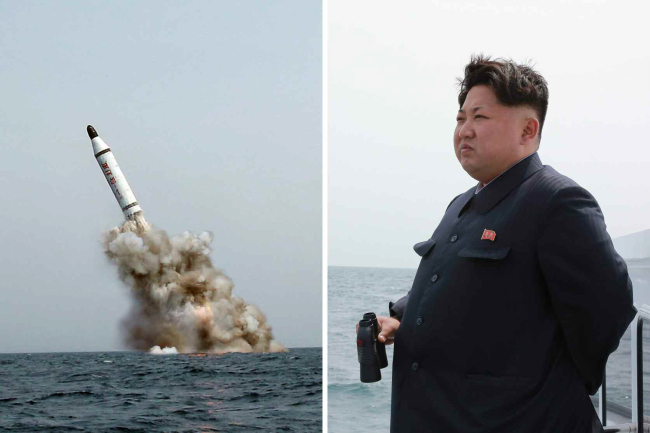Tension between the Koreas flared over the weekend as North Korea test-fired submarine and ship-to-ship missiles and threatened attacks on South Korean vessels it accused of encroaching its waters.
The underwater testing of the KN-11, or “Bukkeuksong” (North Star) missile, stoked concerns over the communist state’s possible acquirement of a submarine-launched ballistic missile, a technology that could make way for a survivable second-strike capability and thus bring its nuclear threat to a new level.
Leader Kim Jong-un oversaw the event, calling it a “world-level strategic weapon” and “eye-opening success,” the official Korean Central News Agency said Saturday. It also unveiled a few photos of the launch, though some analysts said they appear to have been altered.
“A ballistic missile surfaced from the sea and soared into the air, leaving a fiery trail,” the dispatch said. It did not elaborate on the location and date of the launch or details on the missile but its range is expected to be several hundred kilometers.
 |
| Images published in North Korea’s Rodong Sinmun newspaper on Saturday show a ballistic missile believed to have been launched from underwater and North Korean leader Kim Jong-un observing the test-fire. (Yonhap) |
“Through the test, it was verified and confirmed that the underwater ballistic missile launch from a strategic submarine fully achieved the latest military, scientific and technical requirements.”
Also on Saturday, the North fired three short-range anti-ship missiles into the sea off Wonsan, a major port city on the country’s eastern shore. The KN-01 cruise missiles with a range of 100 kilometers were launched over a span of one hour starting from 4:25 p.m., according to the Joint Chiefs of Staff.
“The missiles are the same type as those that were fired in February from the East Sea with Kim Jong-un also in attendance, and the launch was apparently intended for a display of force and performance improvement,” the JCS said in a statement.
The test followed the North Korean military’s repeated warnings to the presidential National Security Office here ― through a border communication channel ― of strikes against Navy vessels that it claimed were breaching the West Sea border.
The KCNA also carried an “emergency special warning” late Friday, vowing “targeted strikes without notice” against the ships.
Pyongyang does not recognize the Northern Limit Line, the de facto maritime frontier in the West Sea, arguing that it was drawn unfairly by the U.S.-led U.N. forces at the end of the 1950-53 Korean War. In 2007, it unilaterally declared a border located farther southward.
Uriminzokkiri, a North Korea propaganda website, again disputed the NLL on Sunday, saying the South staged a “grave military provocation” by claiming the NLL as the sole boundary and violating its territorial waters.
Seoul’s Defense Ministry expressed “grave regret” over the North’s continuous “high-intensity threats” and attempt to shift blame for the heightened tension in the West Sea.
JCS chairman Adm. Choi Yun-hee on Friday pledged robust deterrence and close cooperation during consultations with Gen. Curtis Scaparrotti, commander of U.S. Forces Korea, while visiting the Navy’s western command headquarters earlier in the day in Pyeongtaek, Gyeonggi Province, and holding a video conference with other operations commanders on Saturday to ensure vigilance against any unpredicted provocation.
“In case of the enemy’s provocation, we will inject strong joint forces to sternly punish not only the origin of the attack but the command and supporters,” Choi said during the trip, according to the ministry.
Cheong Wa Dae’s National Security Council, for its part, convened an emergency meeting to examine the current situation and the intention behind the military and verbal threats, as well as the possibility of an actual provocation. Choi briefed its members on the allies’ military readiness posture and ongoing movement across the border.
The participants included NSO chief Kim Kwan-jin, presidential Chief of Staff Lee Byung-kee, foreign, defense and unification ministers, NSC secretariat head Kim Kyou-hyun and Ju Chul-ki, senior presidential secretary on foreign affairs and security.
Of their particular concern is the underwater test, because missile launches from submerged vessels are more difficult to detect compared with land-based ones. Combined with Pyongyang’s publicly professed efforts to miniaturize nuclear warheads to mount on such projectiles, its potential threat could be much greater, experts and officials say.
Satellite imagery analyzed by the U.S.-Korea Institute of Johns Hopkins University in recent months pointed to the Sinpo shipyard as the likely site of the latest experiment. In a separate report the same day, the KCNA said Kim visited a fisheries facility in the eastern coastal city.
In January, the 38 North blog run by the institute cited satellite photos to report that the North appears to have been building a submarine that may house one or two vertical launch tubes for ballistic or cruise missiles and thus may become an “experimental test bed for land-attack missile technology.”
“North Korea’s development of a submarine-launched missile capability would eventually expand Pyongyang’s threat to South Korea, Japan and U.S. bases in East Asia, also complicating regional missile defense planning, deployment and operations,” analyst Joseph Bermudez wrote.
“Submarines carrying land-attack missiles would be challenging to locate and track, would be mobile assets able to attack from any direction, and could operate at significant distances from the Korean Peninsula.”
The U.S. State Department did not offer any assessment of the North’s advancement on its SLBM program but said that launches using ballistic missile technology are a “clear violation” of multiple U.N. Security Council resolutions.
“We call on North Korea to refrain from actions that further raise tensions in the region and focus instead on taking concrete steps toward fulfilling its international commitments and obligations,” the department said in a statement.
By Shin Hyon-hee (heeshin@heraldcorp.com)



